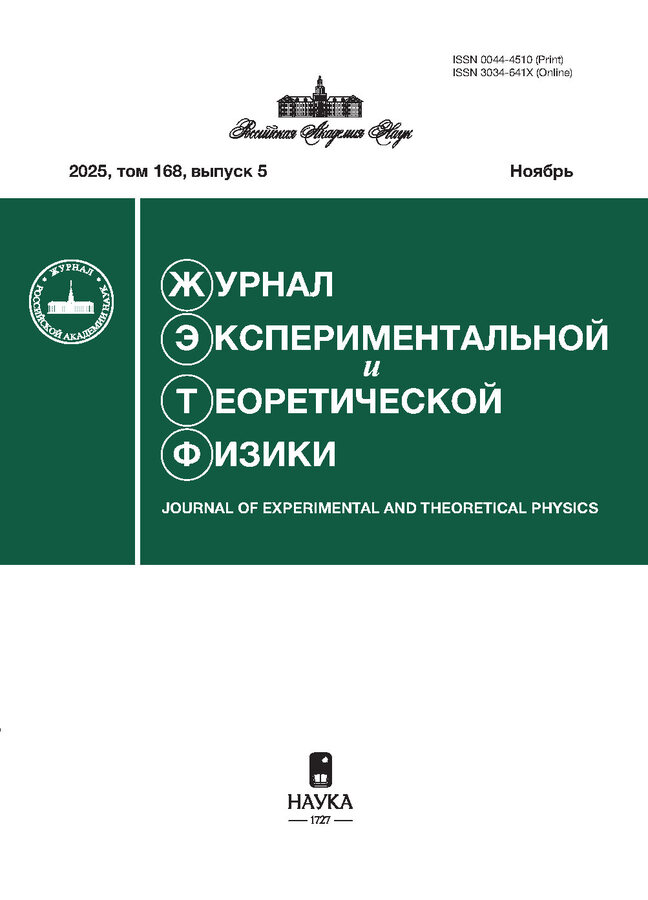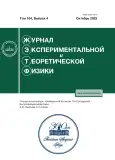Роль вакансий в спин-жидкостной модели Яо–Ли
- Авторы: Поляков В.А1, Перкинс Н.Б2
-
Учреждения:
- Московский физико-технический институт (Национальный исследовательский университет)
- University of Minnesota
- Выпуск: Том 164, № 4 (2023)
- Страницы: 615-625
- Раздел: Статьи
- URL: https://journals.rcsi.science/0044-4510/article/view/247337
- DOI: https://doi.org/10.31857/S0044451023100140
- EDN: https://elibrary.ru/XLNIRM
- ID: 247337
Цитировать
Полный текст
Аннотация
Рассмотрено влияние вакансий на низкоэнергетический спектр возбуждений квантовой спиновой жидкости, реализуемой в точнорешаемой модели Яо-Ли [H. Yao and D.-H. Lee, Phys. Rev. Lett. 107, 087205 (2011)]. Физически, вакансии могут возникнуть по различным причинам, например, вследствие отсутствия магнитных моментов на решетке, либо из-за наличия немагнитных примесей, либо из-за случайного уменьшения локальных связей магнитных моментов с остальной решеткой. Численно показано, что конечная плотность случайных вакансий в этой модели приводит к накоплению состояний вблизи нулевой энергии, что может быть обнаружено в изменении поведения теплоемкости при низких температурах. Более того, показано, что низкоэнергетические моды более локализованы, чем остальные собственные моды. Этот эффект пориллюстрирован с помощью обратного коэффициента участия (IPR). При нарушении симметрии обращения времени, например из-за присутствия магнитного поля, в фермионном спектре модели открывается щель и в ней врозникают локализованные состояния, индуцированные вакансиями. Энергии этих состояний зависят зависят от структуры взаимодействий, отвечающих за нарушение симметрии обращения времени. Статья для специального выпуска ЖЭТФ, посвященного 95-летию Л. А. Прозоровой
Об авторах
В. А Поляков
Московский физико-технический институт (Национальный исследовательский университет)
Email: poliakov.va@phystech.edu
141701, Dolgoprudny, Moscow oblast, Russia
Н. Б Перкинс
University of Minnesota
Автор, ответственный за переписку.
Email: nperkins@umn.edu
55455, Minneapolis, MN, USA
Список литературы
- H. Yao and D.-H. Lee, Phys. Rev. Lett. 107, 087205 (2011).
- W. Witczak-Krempa, G. Chen, Y. B. Kim, and L. Balents, Ann. Rev. Cond. Matt. Phys. 5, 57 (2014).
- C. L. Kane and E. J. Mele, Phys. Rev. Lett. 95, 146802 (2005).
- B. A. Bernevig and S.-C. Zhang, Phys. Rev. Lett. 96, 106802 (2006).
- R. Moessner and J. E. Moore, Topological Phases of Matter (Cambridge University Press, 2021).
- P. W. Anderson, Mater. Res. Bull. 8, 153 (1973).
- L. Balents, Nature 464, 199 (2010).
- L. Savary and L. Balents, Rep. Prog. Phys. 80, 016502 (2017).
- M. R. Norman, Rev. Mod. Phys. 88, 041002 (2016).
- J. Knolle and R. Moessner, Annu. Rev. Condens. Matter Phys. 10, 451 (2019).
- C. Broholm, R. J. Cava, S. A. Kivelson, D. G. Nocera, M. R. Norman, and T. Senthil, Science 367 (2020).
- H. Takagi, T. Takayama, G. Jackeli, G. Khaliullin, and S. E. Nagler, Nat. Rev. Phys. 1, 264 (2019).
- A. Kitaev, Annals of Physics 321, 2 (2006).
- H. Yao, S.-C. Zhang, and S. A. Kivelson, Phys. Rev. Lett. 102, 217202 (2009)
- F. Wang and A. Vishwanath, Phys. Rev. B 80, 064413 (2009).
- C. Wu, D. Arovas, and H.-H. Hung, Phys. Rev. B 79, 134427 (2009).
- R. Nakai, S. Ryu, and A. Furusaki, Phys. Rev. B 85, 155119 (2012).
- V. S. de Carvalho, H. Freire, E. Miranda, and R. G. Pereira, Phys. Rev. B 98, 155105 (2018).
- G. Jackeli and G. Khaliullin, Phys. Rev. Lett. 102, 017205 (2009).
- J. Chaloupka, G. Jackeli, and G. Khaliullin, Phys. Rev. Lett. 105, 027204 (2010).
- A. J. Willans, J. T. Chalker, and R. Moessner, Phys. Rev. Lett. 104, 237203 (2010).
- A. J. Willans, J. T. Chalker, and R. Moessner, Phys. Rev. B 84, 115146 (2011).
- J. Knolle, R. Moessner, and N. B. Perkins, Phys. Rev. Lett. 122, 047202 (2019).
- J. Nasu and Y. Motome, Phys. Rev. B 102, 054437 (2020).
- W.-H. Kao, J. Knolle, G. B. Halasz, R. Moessner, and N. B. Perkins, Phys. Rev. X 11, 011034 (2021).
- W.-H. Kao and N. B. Perkins, Ann. Phys. 435, 168506 (2021).
- W.-H. Kao and N. B. Perkins, Phys. Rev. B 106, L100402 (2022).
- V. Dantas and E. C. Andrade, Phys. Rev. Lett. 129, 037204 (2022).
- P. W. Anderson, Phys. Rev. 109, 1492 (1958).
- I. M. Lifshitz, Soviet Physics Uspekhi 7, 549 (1965).
- A. Y. Kitaev, Physics-Uspekhi 44, 131 (2001).
- C. Nayak, S. H. Simon, A. Stern, M. Freedman, and S. Das Sarma, Rev. Mod. Phys. 80, 1083 (2008).
- J. D. Sau, S. Tewari, R. M. Lutchyn, T. D. Stanescu, and S. Das Sarma, Phys. Rev. B 82, 214509 (2010).
- R. R. Biswas, Phys. Rev. Lett. 111, 136401 (2013).
- K. Damle, Phys. Rev. B 105, 235118 (2022).
- D. A. Ivanov, Phys. Rev. Lett. 86, 268 (2001).
- S. Tewari, S. Das Sarma, and D.-H. Lee, Phys. Rev. Lett. 99, 037001 (2007).
- V. Gurarie and L. Radzihovsky, Phys. Rev. B 75, 212509 (2007).
- R. Roy, Phys. Rev. Lett. 105, 186401 (2010).
- C. Xu, J. Feng, M. Kawamura, Y. Yamaji, Y. Nahas, S. Prokhorenko, Y. Qi, H. Xiang, and L. Bellaiche, Phys. Rev. Lett. 124, 087205 (2020).
- E. H. Lieb, Phys. Rev. Lett. 73, 2158 (1994).
Дополнительные файлы










